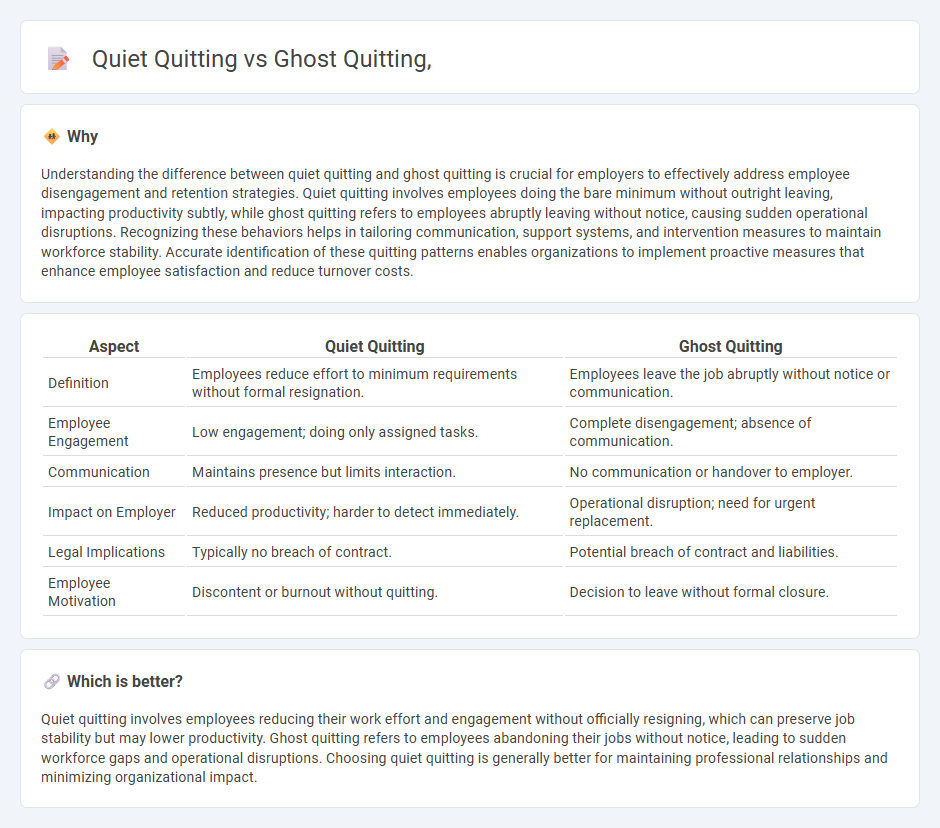
Quiet quitting refers to employees doing the minimum required work without extra effort or engagement, indicating disengagement without formal resignation. Ghost quitting involves employees who leave their jobs without notifying employers, essentially disappearing from their roles unexpectedly. Explore deeper insights into quiet quitting and ghost quitting to understand their impact on workforce dynamics.
Why it is important
Understanding the difference between quiet quitting and ghost quitting is crucial for employers to effectively address employee disengagement and retention strategies. Quiet quitting involves employees doing the bare minimum without outright leaving, impacting productivity subtly, while ghost quitting refers to employees abruptly leaving without notice, causing sudden operational disruptions. Recognizing these behaviors helps in tailoring communication, support systems, and intervention measures to maintain workforce stability. Accurate identification of these quitting patterns enables organizations to implement proactive measures that enhance employee satisfaction and reduce turnover costs.
Comparison Table
| Aspect | Quiet Quitting | Ghost Quitting |
|---|---|---|
| Definition | Employees reduce effort to minimum requirements without formal resignation. | Employees leave the job abruptly without notice or communication. |
| Employee Engagement | Low engagement; doing only assigned tasks. | Complete disengagement; absence of communication. |
| Communication | Maintains presence but limits interaction. | No communication or handover to employer. |
| Impact on Employer | Reduced productivity; harder to detect immediately. | Operational disruption; need for urgent replacement. |
| Legal Implications | Typically no breach of contract. | Potential breach of contract and liabilities. |
| Employee Motivation | Discontent or burnout without quitting. | Decision to leave without formal closure. |
Which is better?
Quiet quitting involves employees reducing their work effort and engagement without officially resigning, which can preserve job stability but may lower productivity. Ghost quitting refers to employees abandoning their jobs without notice, leading to sudden workforce gaps and operational disruptions. Choosing quiet quitting is generally better for maintaining professional relationships and minimizing organizational impact.
Connection
Quiet quitting and ghost quitting both reflect employee disengagement and declining workplace commitment, often resulting from dissatisfaction or burnout. Quiet quitting involves employees doing only the minimum required tasks without extra effort, while ghost quitting occurs when employees disengage mentally or physically without officially resigning. Both phenomena signal underlying issues in organizational culture and management practices that require proactive attention.
Key Terms
Disengagement
Ghost quitting and quiet quitting both signify employee disengagement, yet ghost quitting involves abrupt disappearance without notice, impacting team dynamics and productivity. Quiet quitting, characterized by fulfilling only basic job requirements without extra effort, signals a gradual decline in motivation and commitment, affecting workplace morale. Explore deeper insights on managing disengagement effectively in the modern workforce.
Turnover
Ghost quitting and quiet quitting both significantly impact employee turnover rates, with ghost quitting involving employees leaving without formal notice, causing unexpected vacancies and operational disruptions. Quiet quitting, where employees disengage and reduce effort without resigning, leads to decreased productivity and can indirectly increase turnover by fostering low morale. Explore effective strategies to mitigate turnover linked to ghost and quiet quitting for a more resilient workforce.
Retention
Ghost quitting involves employees disappearing without formal notice, creating sudden gaps and impacting organizational productivity and morale. Quiet quitting refers to employees staying in their roles but disengaging mentally and reducing effort, leading to decreased performance and retention challenges. Explore effective strategies to identify and retain at-risk employees to improve workforce stability.
Source and External Links
Ghosting Vs. Quitting: Do I Have To Give Two Weeks Notice? - Ghost quitting refers to an employee who leaves a job suddenly without any communication or notice, completely cutting off contact with their employer, unlike traditional quitting which involves giving notice; it is different from quiet quitting, where an employee disengages but does not actually leave the job.
Quiet Quitting: What Is the New Workplace Trend - Quiet quitting, also called ghost quitting, is when employees do only the minimum requirements of their job and reject extra effort or overtime, often as a response to burnout or poor work-life balance but without formally leaving their position.
Ghosting, Quiet Quitting, and Ways to Prevent Them - TriNet - Ghost quitting occurs when an employee disappears without notice or communication, while quiet quitting involves employees mentally checking out and reducing effort due to dissatisfaction or burnout, signaling disengagement rather than resignation.
 dowidth.com
dowidth.com